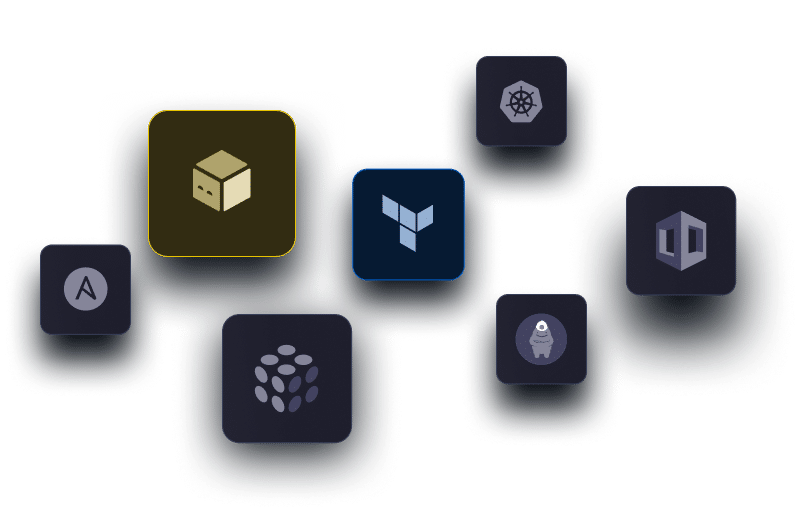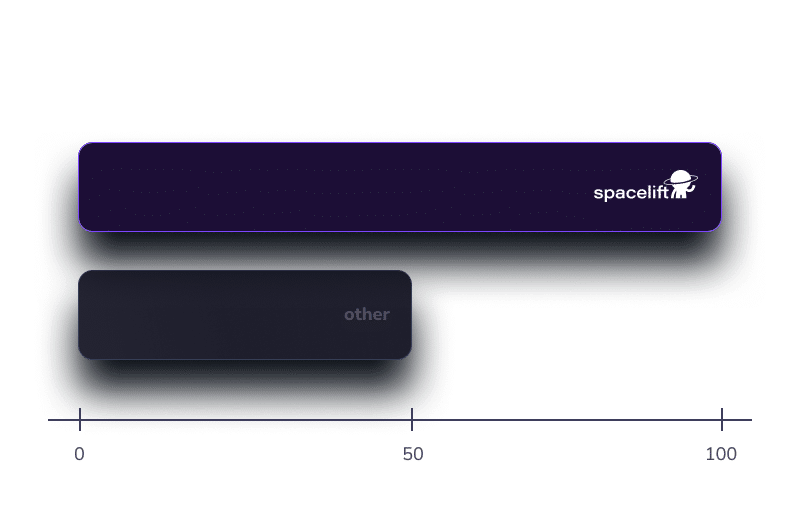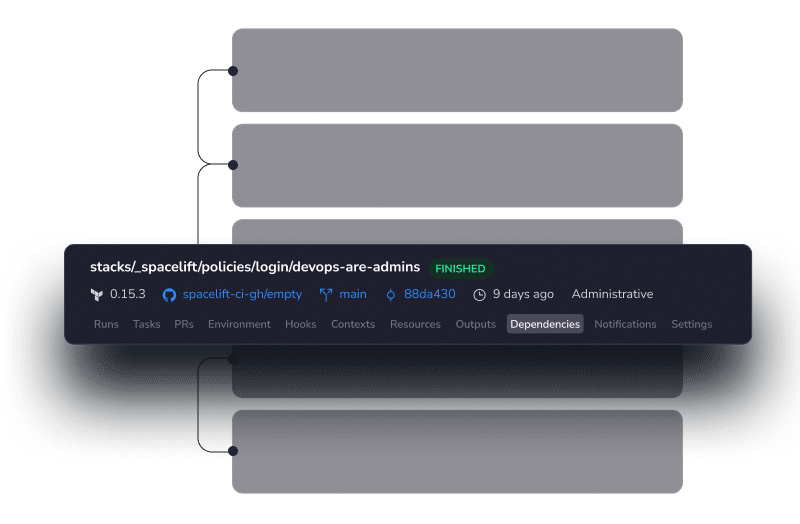[Demo Webinar] Crafting self-service infra with Spacelift Blueprints
Terraform Cloud alternative
Spacelift is a Terraform Cloud alternative that offers a predictable pricing model, instead of the resources-under-management (RUM) model. Our pricing starts at $399 per month, for unlimited deployments and ten users.
And Spacelift offers far more than cost advantages: Build custom multi-IaC workflows that can share outputs, do advanced scheduling of tasks or infrastructure deletion, detect and remediate drift, build self-service infrastructure, and more.

All major IaC platforms supported
- Future-proof your IaC: Spacelift supports Terraform, Terragrunt, OpenTofu, Custom Terraform, Kubernetes, Ansible, CloudFormation, and Pulumi.
- TFC supports Terraform only.

Feature-rich & cost-effective
- Predictable pricing based on concurrency, not RUM.
- Pricing that scales with you for optimal value.
- Unlimited plan and approval policies even in the free tier.

Up to 4x easier failure management
- Get policies across multiple decision points.
- Split deployments among multiple stacks and create dependencies to better identify failures.
- Manage resources with a full inventory management solution.
Trusted by top companies, including:
Spacelift vs Terraform Cloud
Pricing model
Concurrency-based
Resource-based (RUM)
Multi-IaC Workflow
Terraform
Terragrunt
OpenTofu
Custom Terraform
Kubernetes
Ansible
Cloud Formation
Pulumi
Terraform
Nothing else
Policies across various decision points
You can control almost any aspect of the platform through policies
Only the equivalent of plan and approval policies
Integrations
Unlimited
Limited to Run tasks
Full-Workflow Control
Full control over your workflow
Limited to what TFC lets you do
Targeted Runs
Native
Only with env var
Atlantis-style workflow
Plan and apply on pull request
Plan only
Resource Management
Full inventory management solution including visualization, lifecycle tracking, search, and filtering
Resource view only per workspace
Custom Tasks
Run arbitrary tasks on the stack level & task scheduling
No
Private Workers
Yes
Yes
Terraform Provider
Yes
Yes
VCS Integrations
GitHub
GitLab
BitBucket
Azure DevOps
Raw Git
GitHub
GitLab
BitBucket
Azure DevOps
Raw Git
Drift Detection
Yes
Yes
Advanced Scheduling
Yes
No
SSO (OIDC & SAML)
Yes
Yes
State Management
Managed + optional ability to use other backends
Managed only
Credential-less integrations with AWS, Azure, and Google Cloud
Yes
Yes
Flexible Support
Yes
Yes
Private Registry
Yes
Yes
Cost Estimation
Yes
Yes
Why is Spacelift the best alternative to Terraform Cloud?
Predictable pricing model
Terraform Cloud pricing means only the premium tiers provide full value: The free and standard tiers offer just a taste. And the RUM pricing model means you have no control over your monthly bills. Spacelift pricing is based on concurrency, so it’s always predictable. You could secure a 5x IaC cost reduction!
Streamlined migration process
Migrating to a new product can be daunting, but Spacelift provides an automation to make it easy. Our Spacelift Migration Kit speeds up the process by mapping the existing configuration and state to Spacelift resources.
Beyond Terraform
Spacelift doesn’t limit you to Terraform. Manage your entire infrastructure with one platform, and use your choice of other infra-as-code tools for the job at hand.
Sophisticated policy tooling
Policies across the whole platform – create an unlimited number of policies in all tiers, and attach them to as many stacks as you want.
Sophisticated dependencies inside your workflow
Create dependencies between stacks and pass outputs from one to another, using Spacelift’s Stack Dependencies. You can run a stack after another one finishes, and because they are directed acyclic graphs (DAG), it’s easy to have nested dependencies.
Custom Inputs
Unlike other Terraform Cloud alternatives, Spacelift allows you to integrate as many tools as you want in your workflow. You can even define policies for these tools.
GitOps Native
Other Terraform Cloud alternatives offer limited integration with Git providers, but Spacelift is truly GitOps Native. Thanks to push policies, it fully supports arbitrary Git flows, including massive monorepos. It will also use your Git provider APIs (e.g., GitHub’s Checks and Deployments APIs) for ultimate visibility.
Customer empowerment
Scaling is not where Terraform Cloud shines — our customers confirm this. Why waste time troubleshooting, when you could be adding real business value? Spacelift customers spend 90% less time on cloud management and get up and running on AWS in half the expected time.
Terraform resources
How to Migrate From Terraform Cloud to Spacelift
If you want to migrate from Terraform Cloud, we are here to help - learn how to use our Spacelift Migration Kit to speed up the process.
If you want to migrate from Terraform Cloud, we are here to help - learn how to use our Spacelift Migration Kit to speed up the process.
Learn moreTop 10 Terraform Enterprise Alternatives
What is the best Terraform Enterprise (TFE) alternative? See the competitors and their features to find the right tool for your organization.
What is the best Terraform Enterprise (TFE) alternative? See the competitors and their features.
Learn moreTerraform Cloud / Enterprise Workspaces vs. Spacelift Stacks
See the differences and similarities between Terraform Cloud workspaces and Spacelift stacks and examples of how to use them.
See the differences and similarities between Terraform Cloud workspaces and Spacelift stacks and examples of how to use them.
Learn moreTerraform Cloud Agents vs. Spacelift Workers
See the comparison and learn about the differences between Terraform Cloud agents and Spacelift workers.
See the comparison and learn about the differences between Terraform Cloud agents and Spacelift workers.
Learn more
What our customers say
- "Spacelift has enabled Checkout to scale from a handful of deployments per day to averaging over 500 per day. People in my company who have never used IaC are configuring Spacelift in less than a day and starting to do deployments with no real hand-holding."Go to case studyDirector of Engineering - Developer Platform at Checkout.comJoe Hutchinson
- “The great thing about Spacelift is it does what we need it to do without getting in the way. Once we had it installed and configured, it faded into the background of our workflow, letting us operate more efficiently with no hassle.”Go to case studyDevOps Engineering Manager at SpotOnAlex Siegman
- “We needed a way to create consistent run environments and provide auditing. And we increasingly needed to be able to hand off approvals for runs to developers and security staff. Spacelift has made it simple, so it’s had a positive impact on the company as a whole.”Go to case studyLead DevOps Engineer at BraceEric Berg